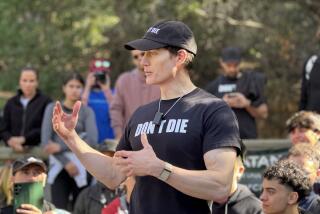Only Mystery Is Why Ben Johnson Was Caught
- Share via
TORONTO — If Dr. Jamie Astaphan is so smart, as he obviously would like for us to believe, why did his prize patient, Ben Johnson, test positive for the anabolic steroid stanozolol at the Seoul Olympics?
That is the only mystery remaining as the track and field phase of the Canadian government’s inquiry into drug use by athletes enters its 14th week today with Astaphan returning to the witness stand.
As Astaphan has given no definitive answer to the question, and as Johnson is not likely to when he appears before the commission of inquiry two weeks from today, we may never be completely sure.
But, as the the commission’s co-counsel, Robert P. Armstrong, bluntly put it to the doctor Friday, previous testimony has produced an “overwhelming inference” that Johnson tested positive for stanozolol because Astaphan gave it to him.
Astaphan defiantly denied it.
Through his first three days of testimony, Astaphan, 43, has revealed a flair for the dramatic. He submitted the secret tape recording of a telephone conversation between himself and Johnson in January, 1988, that apparently proves the sprinter was aware of his use of steroids. Essential to Johnson’s defense has been his contention that he never “knowingly” used performance-enhancing drugs.
Astaphan also has entertained and enlightened the commission with his inside knowledge of the international sports drug scene. Referring to steroids, he said the athletes’ axiom is “if you don’t take it, you won’t make it.” Defining the term shotgunning , he said, “Take everything you can find and hope one works. That’s the California approach.” As for the bond among athletes who use banned substances, he called it “the brotherhood of the needle.”
He said steroids are as easily obtainable in Toronto as pizza. “You don’t have to go out,” he said. “I can take you in a room, you can phone, and they can deliver it.”
But is Astaphan credible? Not only from the line of questioning but also from the tone, it is apparent that Armstrong, and even the commissioner himself, Ontario Associate Chief Justice Charles L. Dubin, do not believe so.
Armstrong has affected the style of an absent-minded professor throughout much of the hearings, but he cast that aside in favor of Clarence Darrow in reviewing previous testimony for Astaphan Friday.
Astaphan, who admitted he had been supervising drug use by Johnson and other Canadian athletes since 1984, put them on a program in the fall of 1985 that included a steroid he identified as Estrogol, which, it has since been learned, does not to exist. It was a milky white substance that came in bottles without labels.
Beginning in June, 1985, and continuing through December, 1987, records from pharmaceutical companies show that Astaphan bought large quantities in the tablet and injectable forms of Winstrol V, a veterinary preparation that contains stanozolol. In its injectable form, it also is milky white.
When Astaphan sold his Toronto practice in 1986 and returned to his native Caribbean island of St. Kitts, he left the bottles of the milky white substance with Johnson’s coach, Charlie Francis, who later transferred them to the home of another sprinter, Angella Taylor Issajenko.
It was from one of those bottles that Johnson was given an injection 22 days before he won the 100 meter final at Seoul. The subsequent drug test revealed traces of stanozolol in his system. Issajenko later turned over 12 of the bottles to the commission, which had them analyzed. They proved to contain Winstrol V.
“The overwhelming inference to be drawn from that is that what you got originally, from whomever you got it, was . . . stanozolol and probably stanozolol in the form of Winstrol V,” Armstrong told Astaphan. “Is that so?”
“No,” Astaphan said without elaboration.
According to Astaphan’s testimony, he received 48 bottles of the milky white substance from an unidentified East German athlete in 1985. The East German told him it was a Japanese drug named Miotolin, which contains the steroid furazabol, but instructed him to refer to it as Estrogol to confuse the “damn Americans.”
Astaphan said he told Francis, Johnson, Issajenko and one other athlete whose name he cannot recall the story in 1985. He said they knew the drug was Miotolin, although they always referred to it as Estrogol.
As for the large quantities of Winstrol V that Astaphan bought, he said that was for a friend on St. Kitts. The friend, Don Hiatt, testified earlier that he used the drug in cattle that he sold to the locals for food and also in sheep, goats, donkeys and dogs that he supplied to a veterinary school.
How does Astaphan explain Johnson’s positive drug test for stanozolol?
So far, he has not, not in so many words. But he testified that on several occasions he found Johnson in possession of drugs that had not been prescribed for him, including stanozolol in May of last year. The overwhelming inference is that Johnson took the stanozolol on his own and that he never would have been caught if only he had followed the instructions of the expert, Astaphan.
Astaphan said that the side effects of steroids are “tremendously exaggerated,” despite evidence presented that Johnson’s liver enzyme level on Aug. 31, 1988, was 61. Normal for Johnson is between seven and 35. Astaphan said that did not concern him. He did, however, seem concerned about the $20,000 to $30,000 that he said Johnson owes him for services performed between 1985 and 1988.
Dubin suggested that Astaphan, as a doctor, should have told the athletes not to use drugs.
“I could have,” Astaphan said, “but then there would have been no reason to send them to compete internationally because they would lose. I just went with the flow of the time.”
More to Read
Go beyond the scoreboard
Get the latest on L.A.'s teams in the daily Sports Report newsletter.
You may occasionally receive promotional content from the Los Angeles Times.






